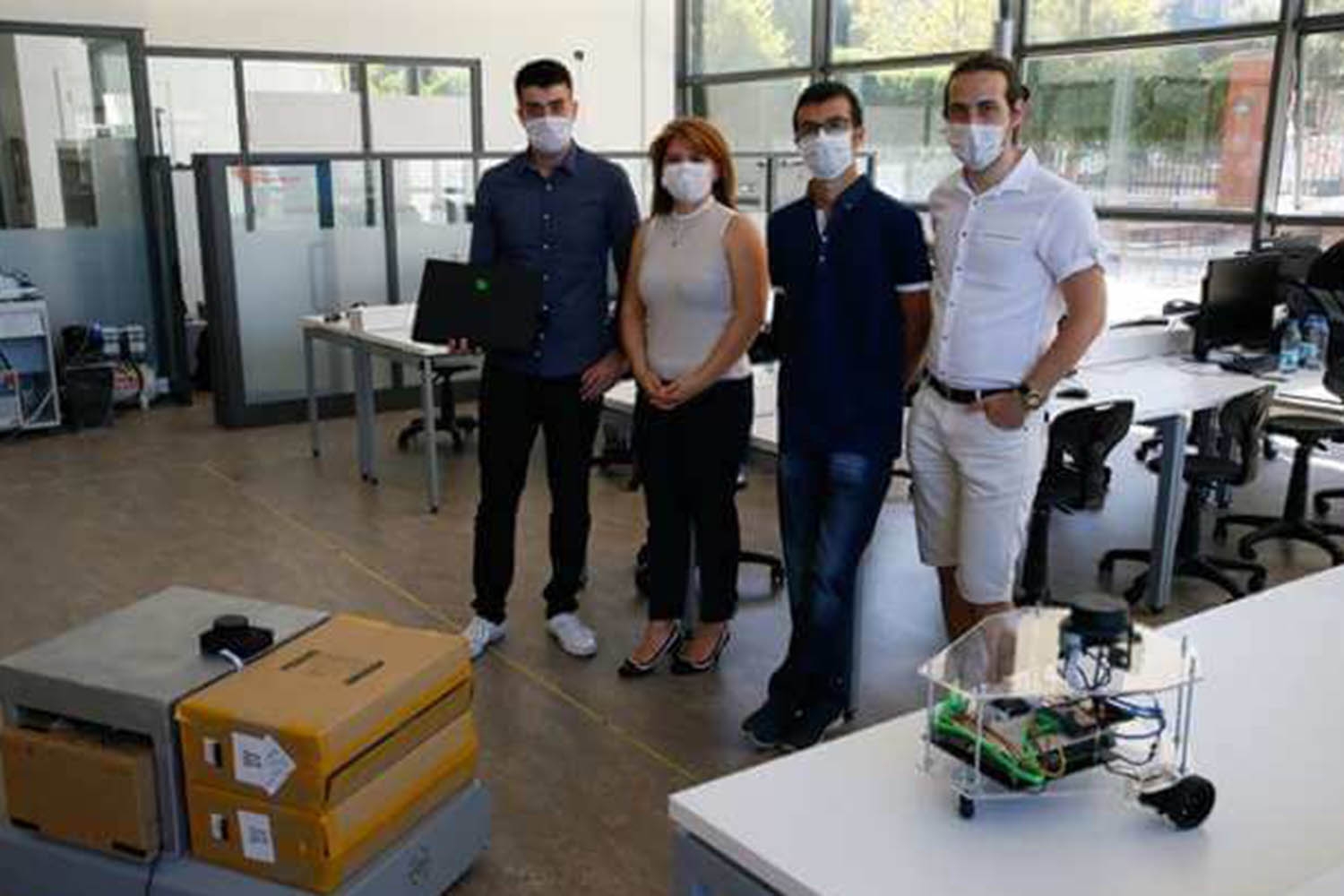
Self-routing autonomous robots by IUE engineers
An autonomous robot that can re-route using artificial intelligence, when it encounters an obstacle, has been developed with the project ...
| Course Name |
Fundamentals of Microprocessors
|
|
Code
|
Semester
|
Theory
(hour/week) |
Application/Lab
(hour/week) |
Local Credits
|
ECTS
|
|
CE 342
|
Fall/Spring
|
2
|
2
|
3
|
6
|
| Prerequisites |
|
|||||||
| Course Language |
English
|
|||||||
| Course Type |
Elective
|
|||||||
| Course Level |
First Cycle
|
|||||||
| Mode of Delivery | - | |||||||
| Teaching Methods and Techniques of the Course | Application: Experiment / Laboratory / WorkshopLecture / Presentation | |||||||
| National Occupation Classification | - | |||||||
| Course Coordinator | ||||||||
| Course Lecturer(s) | ||||||||
| Assistant(s) | ||||||||
| Course Objectives | In this course, students will be introduced to microcomputers and microprocessors. The topics covered will include understanding 80x86 family architecture, Assembly language programming of the 80x86 CPU for low level tasks, introduction of computer organization and architecture of the PC. | |||||||||||||||||||||||||||||||||||||||||||||||||||||||||||||
| Learning Outcomes |
|
|||||||||||||||||||||||||||||||||||||||||||||||||||||||||||||
| Course Description | This course discusses various aspects of the most important component of a computer, the microprocessors. The topics include the fundamental concepts of microprocessors and the relationship between assembler and basic components of a computer, 80x86 family architecture, 80x86 based assembly language programming, computer organization and architecture of the PC. | |||||||||||||||||||||||||||||||||||||||||||||||||||||||||||||
| Related Sustainable Development Goals | ||||||||||||||||||||||||||||||||||||||||||||||||||||||||||||||
|
|
Core Courses | |
| Major Area Courses | ||
| Supportive Courses | ||
| Media and Management Skills Courses | ||
| Transferable Skill Courses |
| Week | Subjects | Related Preparation | Learning Outcome |
| 1 | Introduction to computing microprocessors | Mazidi, Chapter 0 | |
| 2 | The X86 microprocessor | Mazidi, Chapter 1 | |
| 3 | Program segments | Mazidi, Chapter 1 | |
| 4 | Flag register and adressing modes | Mazidi, Chapter 1 | |
| 5 | Control of transfer instructions and simple loops | Mazidi, Chapter 2 | |
| 6 | Arithmetic and logic instructions: Addition, subtraction, multiplication, division and comparison | Mazidi, Chapter 3 | |
| 7 | Signed numbers and strings | Mazidi, Chapter 6 | |
| 8 | Midterm I | ||
| 9 | BIOS & Interrupt programming | Mazidi, Chapter 4 | |
| 10 | 8088 ISA Bus | Mazidi, Chapter 9 | |
| 11 | Interrupts | Mazidi, Chapter 14 | |
| 12 | Memory and memory interfacing | Mazidi, Chapter 10 | |
| 13 | Basic I/O ports and 8255 programming | Mazidi, Chapter 11 | |
| 14 | ISA Bus Interfacing & Review | Mazidi, Chapter 11 | |
| 15 | Semester Review | ||
| 16 | Final Exam |
| Course Notes/Textbooks | The x86 PC Assembly Language, Design, and Interfacing, Muhammad Ali Mazidi, Janice Gillispie Mazidi, and Danny Causey; ISBN 0136092268. |
| Suggested Readings/Materials | INTEL Microprocessors 8086/8088, 80186/80188, 80286, 80386, 80486, Pentium, Prentium ProProcessor, Pentium II, III, 4:7/e, Barry Brey, Prentice Hall, 2006, ISBN10: 0131195069 | ISBN13: 9780131195066 The 8088 and 8086 Microprocessors, Programming, Interfacing, Software, Hardware, and Applications, 4th Ed., Walter A. Triebel, Avtar Singh, Prentice Hall, 2003, ISBN10: 0130930814 ISBN13: 9780130930811. |
| Semester Activities | Number | Weigthing | LO 1 | LO 2 | LO 3 | LO 4 | LO 5 | LO 6 |
| Participation | ||||||||
| Laboratory / Application |
1
|
15
|
||||||
| Field Work | ||||||||
| Quizzes / Studio Critiques |
4
|
10
|
||||||
| Portfolio | ||||||||
| Homework / Assignments | ||||||||
| Presentation / Jury | ||||||||
| Project |
1
|
5
|
||||||
| Seminar / Workshop | ||||||||
| Oral Exams | ||||||||
| Midterm |
1
|
30
|
||||||
| Final Exam |
1
|
40
|
||||||
| Total |
| Weighting of Semester Activities on the Final Grade |
3
|
65
|
| Weighting of End-of-Semester Activities on the Final Grade |
1
|
35
|
| Total |
| Semester Activities | Number | Duration (Hours) | Workload |
|---|---|---|---|
| Theoretical Course Hours (Including exam week: 16 x total hours) |
16
|
2
|
32
|
| Laboratory / Application Hours (Including exam week: '.16.' x total hours) |
16
|
2
|
32
|
| Study Hours Out of Class |
14
|
3
|
42
|
| Field Work |
0
|
||
| Quizzes / Studio Critiques |
4
|
10
|
40
|
| Portfolio |
0
|
||
| Homework / Assignments |
0
|
||
| Presentation / Jury |
0
|
||
| Project |
1
|
20
|
20
|
| Seminar / Workshop |
0
|
||
| Oral Exam |
0
|
||
| Midterms |
1
|
19
|
19
|
| Final Exam |
1
|
25
|
25
|
| Total |
210
|
|
#
|
PC Sub | Program Competencies/Outcomes |
* Contribution Level
|
||||
|
1
|
2
|
3
|
4
|
5
|
|||
| 1 |
To have knowledge in Mathematics, science, physics knowledge based on mathematics; mathematics with multiple variables, differential equations, statistics, optimization and linear algebra; to be able to use theoretical and applied knowledge in complex engineering problems |
-
|
-
|
-
|
-
|
-
|
|
| 2 |
To be able to identify, define, formulate, and solve complex mechatronics engineering problems; to be able to select and apply appropriate analysis and modeling methods for this purpose. |
-
|
-
|
-
|
-
|
-
|
|
| 3 |
To be able to design a complex electromechanical system, process, device or product with sensor, actuator, control, hardware, and software to meet specific requirements under realistic constraints and conditions; to be able to apply modern design methods for this purpose. |
-
|
-
|
-
|
-
|
-
|
|
| 4 |
To be able to develop, select and use modern techniques and tools necessary for the analysis and solution of complex problems encountered in Mechatronics Engineering applications; to be able to use information technologies effectively. |
-
|
-
|
-
|
-
|
-
|
|
| 5 |
To be able to design, conduct experiments, collect data, analyze and interpret results for investigating Mechatronics Engineering problems. |
-
|
-
|
-
|
-
|
-
|
|
| 6 |
To be able to work effectively in Mechatronics Engineering disciplinary and multidisciplinary teams; to be able to work individually. |
-
|
-
|
-
|
-
|
-
|
|
| 7 |
To be able to communicate effectively in Turkish, both in oral and written forms; to be able to author and comprehend written reports, to be able to prepare design and implementation reports, to present effectively, to be able to give and receive clear and comprehensible instructions. |
-
|
-
|
-
|
-
|
-
|
|
| 8 |
To have knowledge about global and social impact of engineering practices on health, environment, and safety; to have knowledge about contemporary issues as they pertain to engineering; to be aware of the legal ramifications of engineering solutions. |
-
|
-
|
-
|
-
|
-
|
|
| 9 |
To be aware of ethical behavior, professional and ethical responsibility; information on standards used in engineering applications. |
-
|
-
|
-
|
-
|
-
|
|
| 10 |
To have knowledge about industrial practices such as project management, risk management and change management; to have awareness of entrepreneurship and innovation; to have knowledge about sustainable development. |
-
|
-
|
-
|
-
|
-
|
|
| 11 |
Using a foreign language, he collects information about Mechatronics Engineering and communicates with his colleagues. ("European Language Portfolio Global Scale", Level B1) |
-
|
-
|
-
|
-
|
-
|
|
| 12 |
To be able to use the second foreign language at intermediate level. |
-
|
-
|
-
|
-
|
-
|
|
| 13 |
To recognize the need for lifelong learning; to be able to access information; to be able to follow developments in science and technology; to be able to relate the knowledge accumulated throughout the human history to Mechatronics Engineering. |
-
|
-
|
-
|
-
|
-
|
|
*1 Lowest, 2 Low, 3 Average, 4 High, 5 Highest

An autonomous robot that can re-route using artificial intelligence, when it encounters an obstacle, has been developed with the project ...

As Izmir University of Economics transforms into a world-class university, it also raises successful young people with global competence.
More..Izmir University of Economics produces qualified knowledge and competent technologies.
More..Izmir University of Economics sees producing social benefit as its reason for existence.
More..